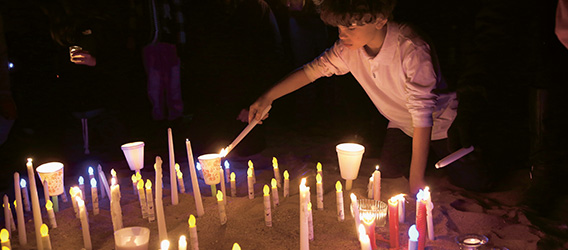Living up to our corporate responsibility
Hurricane Sandy left a bitter impression on the City of New York. Swiss Re applied its core expertise in helping to make the city more resilient.
The memories are still vivid: on 29 October 2012, Hurricane Sandy reached New York City and neighbouring New Jersey after gradually travelling up from the Caribbean. Over the next couple of days, one of the worldʼs most highly developed urban areas was shaken to its core by the stormʼs sheer force. TV viewers around the globe witnessed flood surges of up to 4 metres flooding Manhattanʼs Battery Park while scores of trees crashed into buildings and tore down power lines.
The damage caused by Hurricane Sandy was enormous. Over 650 000 homes were destroyed or damaged; more than eight million people lost power during the storm, of which 2.7 million were in New Jersey and 2.2 million in New York. Three nuclear power stations were shut down, 19 729 flights cancelled and the New York Stock Exchange was closed for two days. And despite all the precautions taken, 44 people were killed in New York City, 160 people in the US and more than 200 along Sandy’s path.

Lighting candles in remembrance of the first anniversary of Hurricane Sandy on 29 October 2013
The citizens of New York and New Jersey responded with admirable courage and solidarity. Neighbours helped neighbours; communities set up spontaneous support groups.
Yet a sense of vulnerability endured, along with a number of questions. Why was the region not better prepared? Did climate change play a role? And most importantly: what should be done to protect against such storms in the future?
Promoting resilience and understanding
According to the Special Report on Extremes (SREX) published by the Intergovernmental Panel on Climate Change (IPCC), extreme weather events have become more numerous and severe. These range from more frequent and severe storms, floods, droughts, heat waves and other natural disasters to sea level rise, crop failures, and water shortages. And while it is impossible to blame climate change for any single event, higher sea levels certainly increased the extent and magnitude of coastal flooding. Since 1900, sea levels around New York City have risen more than 33 centimetres, more than half of which is thought to be due to climate change.
It is against this background that Swiss Re worked on behalf of the City of New York to develop a “Risk Assessment for Hurricane Sandy” using the Economics of Climate Adaptation (ECA) methodology which we developed in collaboration with a range of partners. Our job was to estimate the potential cost of losses to New York City from severe weather in the current climate, how they might increase in a future climate scenario and to assess how those costs could be reduced.
SEA LEVEL
RISE IN NEW YORK
33.5
CM SINCE 1900
An ECA assessment is set up specifically for this purpose. It estimates the impact of climate change and then identifies effective measures to prevent some of the damage that would result from a natural catastrophe. We have applied the ECA methodology to more than 20 regions since 2008, from Mali, to Miami to Maharashtra, India. These assessments have focused on a variety of perils, such as hurricanes or drought, to an equally wide range of consequences, such as to agriculture and health.
In New Yorkʼs case, the ECA study led to some stark conclusions: Hurricane Sandy caused around USD 19 billion worth of damage to New Yorkʼs five boroughs. And while a storm leading to this kind of loss can be expected to occur on average once every 70 years, climate change is expected to make them noticeably more frequent: once every 50 years by the 2050s under the climate change scenario used in the project. The study further envisioned that damage from a storm like Sandy would likely increase more than fourfold, to USD 90 billion, and that the average loss per year from windstorms and storm surge, meanwhile, could be expected to rise from around USD 1.7 billion today to USD 4.4 billion by the 2050s if no action were taken.
Engaging with various stakeholders and the Mayor’s Office of Long-Term Planning & Sustainability, we identified a range of adaptation measures to be taken, quantifying their net economic benefit. Some of the measures under consideration included beach renourishment, wetlands restoration, raising bulkheads in low-lying neighbourhoods, retrofitting public housing units and nursing homes, and hardening key electric transmission and distribution infrastructure such as vulnerable overhead lines.

Part of a modular home unit is lifted into place at the site of a home destroyed by Hurricane Sandy. Much of the damage has been repaired but some is still visible.
Ultimately the City outlined some 250 measures that could reduce damage in the future, most of which focus on coastal protection, city infrastructure and the built environment. The plan laid out the need for investments of about USD 20 billion, USD 15 billion of which are already funded.
Through this process, and through consultation with hundreds of stakeholders and experts, City authorities now have a credible, long-term plan to better protect its population against the impact of natural disasters.
While efforts to reduce greenhouse gas emissions to combat climate change remain vital, Swiss Re expects that the ability to adapt to its effects will become ever more important — and we are keen to provide communities with the means to do so.
Further reading:
Swiss Reʼs 2013 Corporate Responsibility Report will be published in June 2014. It will be available on swissre.com/publications.